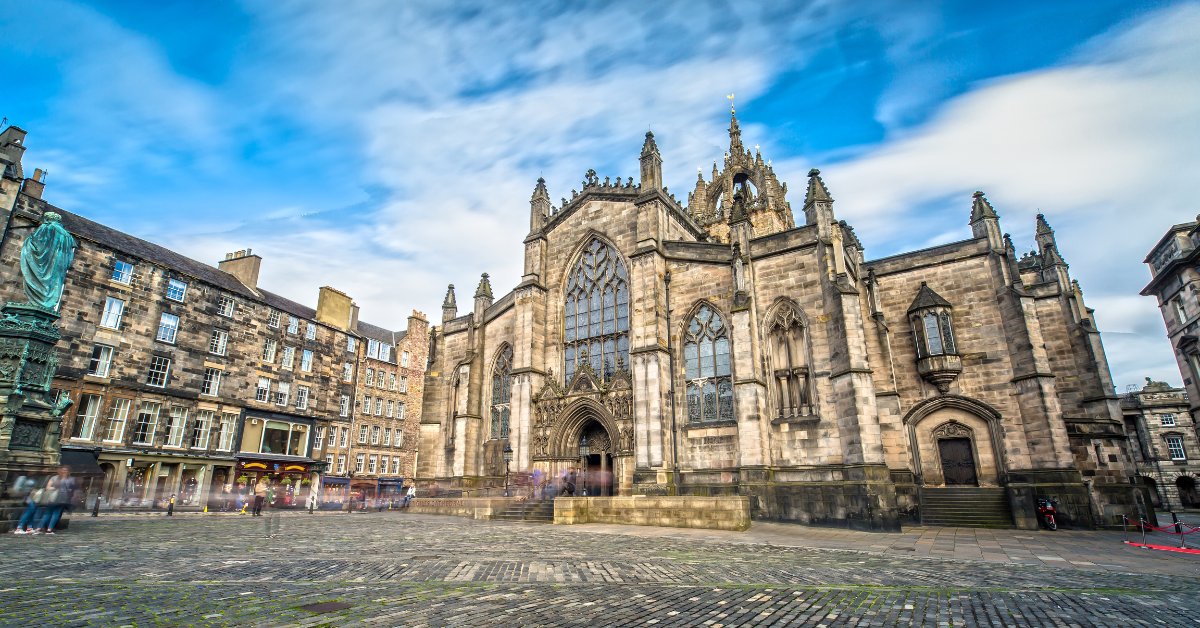Edinburgh, the capital of Scotland, is a city where history and art harmoniously coexist. In Japan’s past, it was sometimes written as “以丁堡”, a Kanji rendering that reflected Japan’s intellectual effort to understand foreign cultures through its own language. This article explores the background of this unique notation and reveals how modern Japanese people perceive Edinburgh’s timeless charm.
The Kanji “以丁堡” and Its Origins
Although there is no official Kanji representation for Edinburgh, historical records show that “以丁堡,” “壹丁不,” and other variants were occasionally used. These were phonetic transcriptions, chosen for their sound rather than their meaning.
During the late 19th century, Japanese writers often relied on Chinese-based phonetics or Japanese readings of Kanji to express foreign words. For example, London was “倫敦,” Paris was “巴里,” and Berlin was “伯林.” In the same way, “以丁堡” was created to make the sound of “Edinburgh” more approachable to Japanese readers.
| Kanji Form | Reading | Corresponding City |
|---|---|---|
| 倫敦 | Rondon | London |
| 巴里 | Pari | Paris |
| 伯林 | Berurin | Berlin |
| 紐育 | Nyūyōku | New York |
| 以丁堡 | Edinbara | Edinburgh |
These notations disappeared after World War II, but they still represent the uniquely Japanese way of interpreting the world through the written word.
Why Foreign Place Names Were Written in Kanji
From the Meiji to early Shōwa periods, newspapers, maps, and diplomatic documents commonly used Kanji to write foreign place names. At that time, Katakana spellings were not yet standardized, so Kanji served as a practical and visually accessible tool for understanding foreign geography.
Moreover, Kanji provided a sense of imagination and familiarity—the meaning and appearance of the characters helped readers form an image of the place even without seeing it.
| Era | Writing Method | Characteristics |
|---|---|---|
| Early Meiji | Kanji transcription | A creative way to interpret foreign words |
| Taishō | Mixed Kanji–Katakana | Transitional period as education expanded |
| Postwar | Katakana only | International standardization of language |
Thus, “以丁堡” symbolizes the intellectual effort of the Japanese to comprehend the world through their own linguistic system.
The Timeless Beauty of Edinburgh
Edinburgh is not only Scotland’s political capital but also its cultural and historical heart. Its Old Town and New Town are UNESCO World Heritage Sites, combining medieval charm with Enlightenment-era elegance.
At the city’s center stands Edinburgh Castle, a fortress that has witnessed centuries of Scottish history. Around it stretches a labyrinth of cobblestone streets, Gothic architecture, and atmospheric alleyways.
Meanwhile, the New Town reflects 18th-century urban planning, filled with Georgian symmetry and sophistication—making Edinburgh one of the best-preserved cities in Europe. The city is also known as the “City of Literature,” as J.K. Rowling wrote parts of the Harry Potter series there.
| Area | Characteristics | UNESCO Registration |
|---|---|---|
| Old Town | Medieval streets, castle, and narrow alleys | 1995 |
| New Town | Neoclassical urban design and harmony | 1995 |
How Japanese People Perceive Edinburgh
To many Japanese people, Edinburgh represents history, intellect, and tranquility. Its fog-shrouded skyline and warm lamplight evoke an atmosphere of subtle elegance rather than flamboyance. The city exudes a timeless dignity that appeals to travelers seeking depth rather than spectacle.
| Aspect | Japanese Impression |
|---|---|
| Historical richness | Ancient castles and cathedrals preserved |
| Intellectual charm | A university city with academic prestige |
| Artistic culture | The world-famous Edinburgh Festival |
| Harmony with nature | A city between the hills and the sea |
For Japanese travelers, Edinburgh is not just a destination—it is a place to reflect, learn, and feel the quiet power of culture.
Edinburgh’s Sporting Spirit
Beyond art and history, Edinburgh is also a city of sports and passion. Rugby, in particular, is a symbol of Scottish pride. The Murrayfield Stadium, home of Scotland’s national team, fills with fans waving blue and white flags whenever international matches take place.
The city’s universities, such as the University of Edinburgh and Heriot-Watt University, promote both scholarship and physical activity, emphasizing a balance between intellect and athleticism. Popular sports include football, athletics, tennis, and golf, reflecting a culture that values health and community.
| Sport | Distinctive Feature | Community Involvement |
|---|---|---|
| Rugby | National identity and passion | Families and fans fill the stadium |
| Golf | Originated in Scotland, many elite courses nearby | Accessible to locals and tourists |
| Marathon | Edinburgh Marathon held annually | Attracts global participants |
Sports contribute to the city’s vitality and unity, connecting locals and visitors through shared enthusiasm.
What “以丁堡” Reveals About the Japanese Language
The term “以丁堡” is more than a phonetic transcription—it is a reflection of Japan’s linguistic creativity and adaptability. Kanji allows meaning to coexist with sound, enabling readers to imagine and internalize the essence of a place.
This expression shows the Japanese inclination to interpret foreign culture within their own linguistic and emotional framework. Even though Katakana has replaced such forms, the old Kanji transcriptions remind us that language can be a bridge between cultures, not just a tool of communication.
Conclusion
When Japan once called Edinburgh “以丁堡,” the world felt distant. Yet, that single phrase embodied a desire to understand, connect, and translate the unknown.
Today, Edinburgh stands as a city where history, culture, and sport coexist in perfect harmony. Its grand castle, elegant architecture, intellectual atmosphere, and passionate sporting traditions continue to captivate people across the globe.
For Japanese visitors, Edinburgh remains a city of intellect and emotion—a place where serenity meets strength. In that sense, the spirit of “以丁堡” lives on, echoing the same curiosity and respect that first inspired Japan to give the city its Kanji name.






